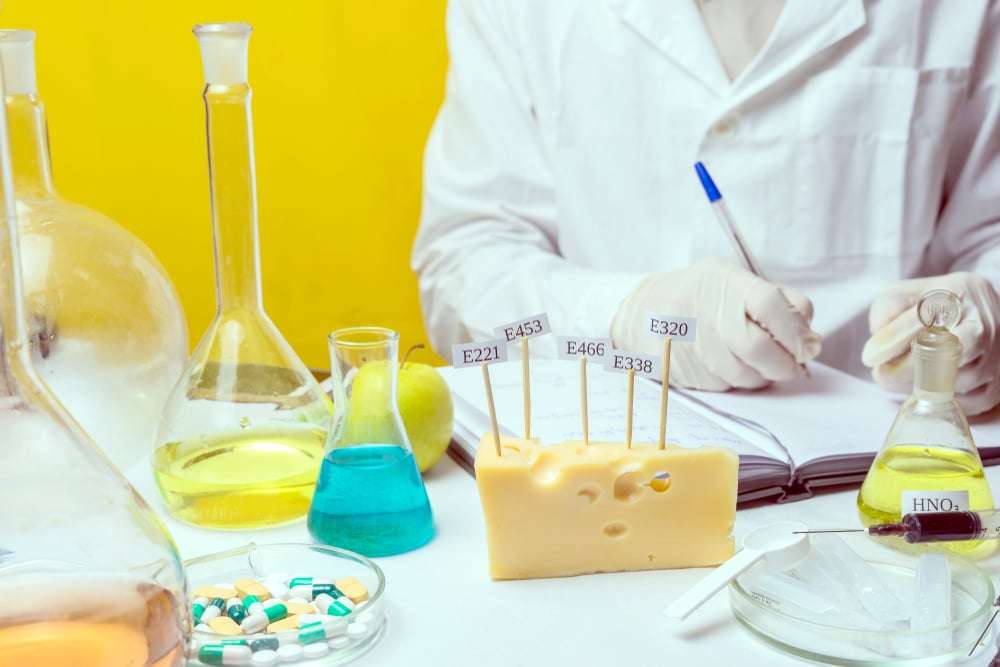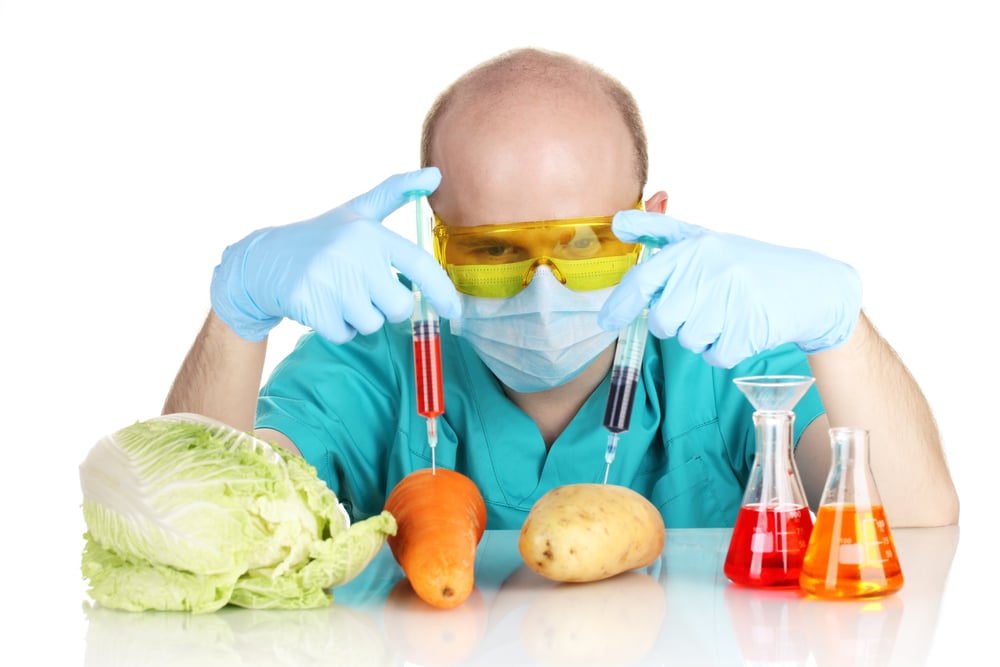The way we eat today is a far cry from the way we ate 100 years ago, let alone 1,000 and 10,000 years. And I’m not just talking about the invention of Pad Thai, lasagna, or avocado toast. Perhaps one of the greatest departures from traditional diets is the addition of artificial additives—chemicals in food synthetically formulated to make ingredients and ready-made meals look, taste, keep, and act in whole new ways. Weird ways. Sometimes, harmful ways.
What are the risks of food additives? Are all chemicals in food dangers? And, are there risks of not adding preservatives to food? These are all great questions to ask when on the hunt for purer, more natural and nutritious foods.
In this blog, we’ll scratch the surface of the food additive world—maybe blow your mind once or twice 🤯—and leave you with a better understanding of what’s actually in the food you eat and what effects it may have on your overall health, weight, and physical appearance.
Article At A Glance
- What are food additives?
- Types of additives
- Side effects
- Additives to avoid + healthy alternatives

What Are Food Additives?
Most of us are familiar with “food additives” as a term, even if we’re a little cloudy on what it actually encompasses.
Food additives are substances added to food to preserve certain qualities such as shelf-life, flavor, color, taste, and even structure or firmness. They range from healthy to harmful, and are found in just about everything, from canned soup to packaged meals and even health food, such as lettuce.
Some additives are natural and pretty much harmless, such as salt or vinegar—used for thousands of years as natural preservers. And then there are food additives to avoid at all cost, which somehow are still legal for use. 🤯
Knowing which chemicals in food to avoid can be tricky. Lengthy ingredient names can conjure ideas of toxic compounds that slowly ail our bodies and hinder our complete health. While this is true for certain (but not all) artificial additives, it’s important to remember that all foods are made up of chemical compounds, many of which are vital to our wellbeing. Ascorbic acid, for instance, sounds like something that could eat away at you, like alien blood in some sci-fi movie. In reality, it’s the scientific name for Vitamin C.
This makes answering the whole question of what are the risks of food additives more complicated than it should be. But, generally, when we discuss chemicals in food, we’re talking about additives, specifically food additives to avoid.
Types Of Additives & Chemicals In Food
There are thousands and thousands of different additives found in (and on) just about everything in your shopping cart. Many are totally harmless; others are terribly horrendous. To make matters more confusing, there are around 20 different types/groups of food additives.
- Acidulents give certain foods an acidic (sour) taste and are often natural, such as with vinegar, citric acid, and more.
- Acidity regulators can balance the pH (acid/alkaline levels) of foods and are sometimes used to activate a food’s enzymes.
- Anticaking agents inhibit powders from clumping, caking, or sticking.
- Antifoaming agents are added to foods to prevent them from foaming. Contrast that with foaming agents which help food foam.
- Antioxidants can be used as preservatives, inhibiting oxygen from degrading food quality. Vitamin C (absolutely essential to our wellbeing) is a natural example.
- Bulking agents increase the mass of food without changing its taste. Starch is a popular bulking agent.
- Fortifying agents such as vitamins, minerals, and certain dietary supplements increase the nutritional value of certain foods, such as B vitamins or iron in cereal, and vitamin D in almond milk.
- Food coloring can replace colors lost during preparation or be added to make food look more appealing. That bright pink farm-raised salmon at the food store… doesn’t look like that in nature.
- Color retention agents preserve a food’s color, as opposed to add to or replace it.
- Emulsifiers allow water and oils—which normally don’t mix well—to stay together. Emulsifiers are used a lot in mayonnaise, ice cream, milk, salad dressings, and lots more.
- Flavors, as you’d guess, give food a desired taste or smell. They can be natural or artificial.
- Flavor enhancers (adjuvants) artificially enhance foods’ taste. Salt, sugar, and MSG are more naturally occurring food enhancers.
- Flour treatment agents improve the color and/or baking ability of flour.
- Glazing agents make foods shiny in appearance and give a protective look that preserves their shelf appeal. Apples often use the glazing agent shellac, which is used in things like nail polish and wood finishing… and comes from bug poop. 💩[1]
- Humectants stop food from drying out and looking or going bad.
- Tracer gas makes it easy to test whether certain foods have been properly packaged to ensure shelf life. Potato chips use tracer gas.
- Preservatives extend the shelf-life and stop food from going bad so quickly. They’re among the most unpopular additives, given the unnatural effect they have on food. However, there are many natural preservatives, such as salt, that have been used for thousands of years.
- Stabilizers help to stabilize emulsions and give certain foods a firmer texture. Pectin is a popular stabilizer in jam.
- Sweeteners are some of the most well-known additives, and have become popular alternatives to sugar.
- Thickening agents increase the viscosity of foods like soups and other water-based recipes.
- Packaging: bisphenols (such as Bisphenols A, or BPA), phthalates, and perfluoroalkyl chemicals (PFCs) are indirect additives found in food packaging or manufacturing. Their use has raised lots of red flags in recent years, including cancer-causing properties.
Within these groups are dozens of food additives to avoid, as they carry with them a host of dangerous side effects that range from irritation to weight gain, cancer to neurological effects. Due to regulatory loopholes, they often bypass inspection and can be touted as healthy. 🤯[2]

What Are The Risks Of Food Additives?
Don’t panic. Most food additives are safe. Only a few are insidious and can lead to side effects. As we’ll explore below, side effects from certain chemicals in food are broad ranging and can affect nearly all who consume them or just a small demographic, such as those with particular allergies or pre-existing conditions. It’s smart to ask yourself, What are the risks of food additives? Doing so will help you pinpoint the food additives to avoid versus those you can feel comfortable consuming.
Among the known side effects of dangerous chemicals in food are:
- Obesity & weight gain
- Cancer
- Insulin disorders
- Endocrine disorders
- Allergic reactions
- Skin issues and reactions
- Digestive disorders
- Nervous disorders
- Possible neurological disorders
- Respiratory issues
- ADHD symptoms (especially in children)
We’ll dive into some of these issues as they pertain to our list of seven additives to avoid.
Food Additives To Avoid
It can be extremely difficult to know what food additives to avoid and what food additives to feel comfortable with. Certain chemicals in food are not (or not yet) shown to impact our health, while many “staple additives” suddenly make headlines when research reveals harmful side effects not priorly known.
If you’re wondering how dangerous chemicals make into our food… well, join the club. A lot of it comes down to a longstanding FDA rule that allows additives “generally recognized as safe” (GRAS) to bypass scrutinous inspection before getting on shelves, explains NPR.
“The loophole was originally intended to allow manufacturers of common ingredients like vinegar and table salt — when added to processed foods — to bypass the FDA’s lengthy safety-review process. But over time, companies have found that it’s far more efficient to take advantage of the exemption to get their products on shelves quickly. Some of these products contain additives that the FDA has found to pose dangers. And even ingredients the agency has agreed are GRAS are now drawing scrutiny from scientists and consumer groups that dispute their safety,” the article explains.
GRAS ingredients aren’t legally considered additives (despite the fact that, you know… they are additives). This means companies putting them in, on, or around our food get to self-determine whether they’re safe. 😳
Now, to be sure, many of these ingredients are, in fact, totally fine for consumption. It just means you want to be on the lookout.
How do you do this?
Well, short of going full permaculture and growing your own food with ultra-organic soil, you can make dietary choices to limit or avoid chemicals in food known to cause harm. This list will help. (A lot!)
1. Refined sugar
What is it?: Refined sugar is sugar that has been extracted from corn, sugar cane, or sugar beets and refined so that it can be added to food to boost sweetness and extend shelf life.
Where you’ll find it: In practically everything. Jams, jellies, soft drinks, ice creams, cereals, yogurt, BBQ sauce, peanut butter, packaged foods, regular and alternative milks, energy bars… the list goes on.
What does it do?: Enhanced flavor. Also, obesity, excess belly fat, diabetes, depression, liver disease, dementia, certain cancers. [3, 4, 5, 6, 7, 8, 9]
2. Brominated vegetable oil (BVO)
What is it?: A combination of vegetable oil and bromine, the same stuff used as a fire retardant.
Where you’ll find it: Primarily in citrus-flavored soft drinks and sports drinks. It was removed from Mountain Dew and other Pepsi products, as well as Coca-Cola products around 2014. It’s banned in Japan and Europe.
What does it do?: Excessive BVO intake can lead to headaches, memory loss, impaired coordination, autoimmune diseases, cancer, and hypothyroidism (and under-activity of the thyroid gland, contributing to weight gain, depression, weakness, muscle pain, and more). [10]
3. Sodium nitrite
What is it?: A preservative used primarily in cured meat.
Where you’ll find them: Cured and processed meats, bacon, hot dogs, jerkies, some fish.
What does it do?: Sodium nitrite helps fend off deadly bacteria and give meat a red color. But, statistically significant research suggests it can be carcinogenic, due to subsequent nitrosamines. Avoid eating cured meats with nitrites on a regular basis. [11]
4. High fructose corn syrup
AKA: HFCS, glucose-fructose, isoglucose, glucose-fructose syrup)
What is it?: High-fructose corn syrup is an artificial sweetener made from corn starch, used to sweeten foods
Where you’ll find it: Soft drinks, candies, sweetened yogurts, some breads, canned fruit, fruit juices, condiments, packaged meals, some granola/nutrition bars, many peanut butters, and basically anything marketed to kids.
What does it do?: High-fructose corn syrup is linked to a host of weight-related diseases, such as obesity, heart disease, and diabetes. While HFCS doesn’t directly induce these side effects, its sweet flavor, caloric uptick, and prevalence in everyday foods promotes eating large amounts of this high-calorie, low-nutrition sweetener. [12]
5. Partially hydrogenated vegetable oil
What is it?: When hydrogen gas is forced with super-high pressure into vegetable fat it creates an artificial fat known as partially hydrogenated vegetable oil, a trans fatty acid.
Where you’ll find it: Margarine, commercial pastries and crackers, cheap frozen foods, cheap canned soups, fast food, certain non-dairy creamers, big-name peanut butter, fried foods, and more.
What does it do?: PHVO is a very cheap ingredient that makes food last a very long time. When these Frankenfoods are consumed, they can lead to cholesterol imbalance and severe cardiac disease. Perhaps just as concerning is that trans-fats are able to cross the placenta barrier and are found in identical blood levels in newborns as in their mothers. An estimated 30,000-100,000 premature coronary deaths each year in America are the result of excessive PHVO intake. [13]
6. Artificial food coloring
What is it?: Artificial food colorings are synthetic dyes used to make food look more saturated or otherwise more visually appealing.
Where you’ll find them: Cereals, farm-raised salmon, Maraschino cherries, candy, popsicles, ice cream, sports drinks, condiments, soda, chips, popcorn, sauces, baked goods, preserved/canned fruits & veggies, canned soups, snacks, and other brightly colored foods.
What does it do?: Food dyes make items more visually appealing. Health concerns range from cancer to hyperactivity in children. Red #3 was banned from cosmetics by the FDA for its links to thyroid cancer, but remains legal for use in foods. Tellingly, when artificial food dyes and preservatives are removed from their diet, 73% of ADHD children showed a decrease in their symptoms. [14] Check the nutrition label and opt for whole foods or those with natural coloring instead.
7. Propionate
What is it?: Propionate is a naturally occurring short-chain fatty acid used as a preservative.
Where you’ll find it: Processed meat, canned fish, sausage casings, flavored milk, certain cheeses, puddings and other dairy products, bread and baked goods, nut butters, vinegar, commercial potato salad.
What does it do?: Propionate can disrupt your hormone balance and lead to insulin spikes and obesity. [15]

The Bottom Line
Many of the additives recognized as “generally safe for consumption” truly are; but many are additives to avoid.
The FDA hasn’t shown to be reliable in monitoring what additives make it into our food, but their recommendations (along with those of the European Food Safety Authority [EFSA]) can still be helpful when trying to understand what are the risks of food additives.
Learning how to read a food label can also go a long way in identifying chemicals in food that you’re trying to err away from. Just keep in mind, not everything legally has to be noted on the nutrition label.